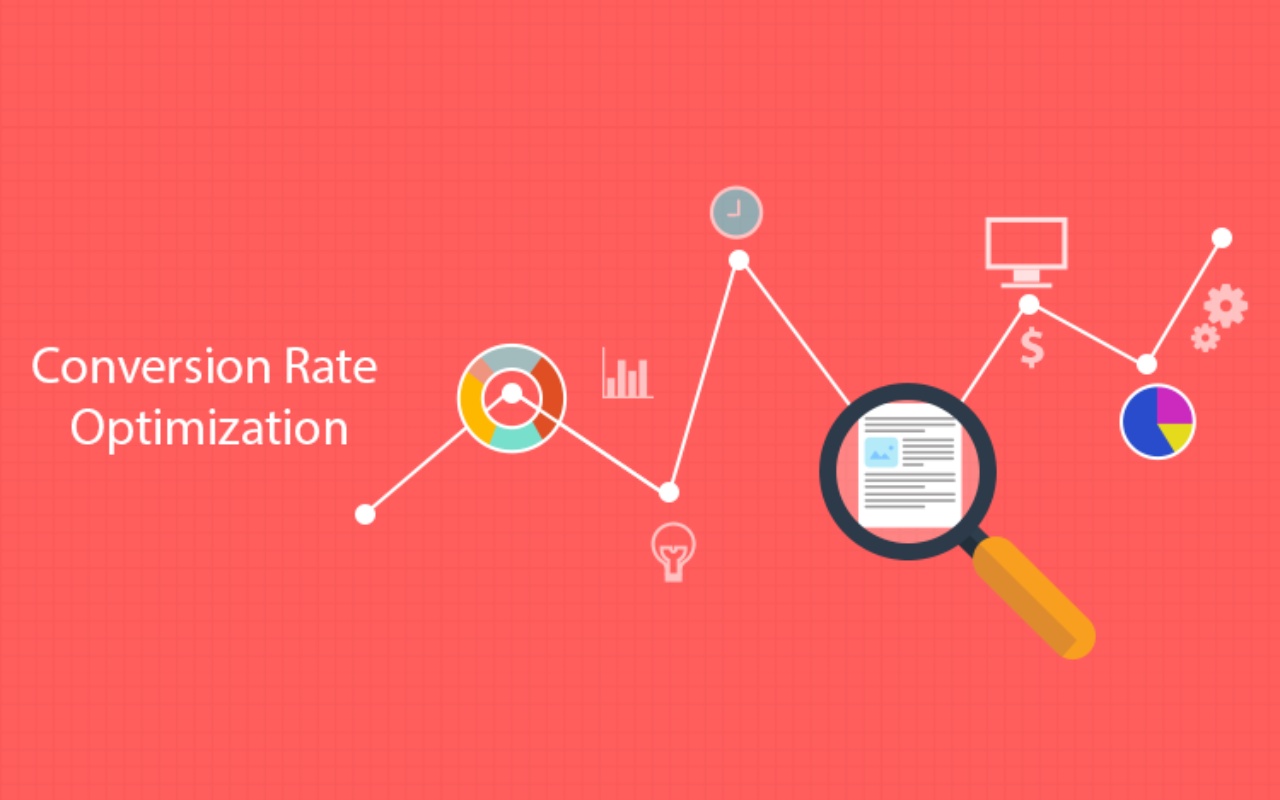Did you know that only a fifth of businesses are happy with their conversion rate?
A fifth! Can you imagine that? 😲
That’s why even the most skillful companies are turning to integrate conversion rate optimization (CRO) into their digital marketing strategy.
However, optimizing the conversion rate can sometimes be misleading.
“Convert” doesn’t just mean making a sale.
Having a good conversion rate can represent all kinds of measurables. Unless you clearly define what you expect as “conversion,” you’ll not be able to achieve your goal.
And this is the goal: if you want to have a better conversion rate, you need to learn how to better articulate your customer experience to enable people to take the desired action.
To be successful as a digital marketer, you need to be able to optimize your marketing throughout your evolution, making small changes that improve returns from 1% to 10% or even more.
Today, we’ll help you make that happen. We’ll cover the optimization methodology, a procedure you can repeat to improve results on your website.
We’ll also talk about the jargon or vocabulary and the terms you need to know as an optimizer, the statistical data you need to take, and the roles within your organization to identify the manager.
Here we go!
1. The Method of Properly Performing CRO
Let’s start with a few basics.
The main goal of optimization is to improve conversion rates depending on the traffic you already have and generally with the assets at your disposal.
We are not going to deal with the topic of “how to gain website traffic”, but rather how to optimize your current traffic.
It is also important to know that optimization is a dedicated operation that you can reproduce. It is not a one-off activity. You will work by following the procedure, then repeat the operation again.
As you can always improve your results, no matter how much improvement you make, you can continue to do more. This is the reason why we describe the CRO process as a cycle:
You will start by setting your goals.
Secondly, you’ll identify the significant data, then analyze it in order to derive a hypothesis.
Afterward, you will design the variants, implement the technology, and test your hypotheses.
Next, you will analyze the results, in order to allow you to come up with new drafts and ideas for new tests.
After that, the operation just starts again. With optimization and testing, this cycle repeats itself over and over again.
Now let’s discuss what you are going to do at each stage of the cycle.
1.1 Identify Your Goals

A clearly defined objective marks the start of the operation.
You should remember that you can’t optimize what you really want without clear goals. So you should understand what you really want to achieve.
Suppose you are going to try to optimize your homepage. We will take the Digital Marketer home page as an example.
Keep in mind, however, that optimizing home pages is far from easy due to the fact that several tasks should be performed and everyone wants to highlight their own goals.
For instance, the sales team goes out of their way to find new prospects.
On the other hand, the acquisition team is studying the best strategy to convert traffic to email.
You understand the principle. Everyone is working to get a little space on the home page.
Here is the goal to achieve: a home page allows you to tell visitors “you are here”. This interface allows them to give their opinion on the relevance of your business, and if so, they can specify where they are and where they need to go.
A definition of one or more of the following three types of objectives is essential to optimize this operation:
- A short-term goal, like one-click or the execution of a form on a page.
- A campaign goal, such as leads generation or purchases.
- A long-term goal, such as the impact of your long-term cost, your net income, the average cost of your orders, or the quality of your “leads”.
1.2 Collect Your Data
As soon as you have identified your goal, you need to set a benchmark for your statistics. For each metric, insert your current data, your potential data (the numbers you are targeting), and your user data.
Once you’ve set your goal, you need to provide a baseline for your stats. For each, attach your current numbers, the numbers you covet (the ones you are targeting), and the data of your users.
Gather this data before making any assumptions.
For optimizers, this is rule # 1: leave all assumptions aside. You and your colleagues all have ideas about what works well and what does not, user expectations, and more. These ideas, however, are still assumptions.
You should never make decisions based on assumptions. Take a look at your concepts and let your users give you their opinion on what isn’t working.
So where do you collect your data from?
- For the statistics of your site, go to Google Analytics.
- To explore more on the statistics on user behavior, you can use a tool like TruConversion.
- Want some information on customers and their email, use those offered by your email service such as MailChimp.
- For payment information, take a look at your payment platform such as Stripe, Paypal, etc.
1.3 Analyze the data

The secret to CRO success is using the right data (which you just collected) to launch relevant optimization campaigns.
Analyze your data and ask yourself questions like these:
- What is my conversion rate (is it satisfying)? Use analytics or CRM data to get answers.
- What is weakening my conversion rate? Use user behavior data to figure it out.
- How or why does this negatively impact my conversion rate? To answer this question, you’ll take the next step in the CRO process and develop a hypothesis.
1.4 Develop a Hypothesis
This is the starting point for optimization.
Without any assumptions, you cannot optimize because you have no idea what you need to improve. At this point in the process, you know all the points that could put your conversion rates at a disadvantage.
Now you need to make some assumptions about which method you are going to use to solve the problem you have identified.
How are you going to establish a hypothesis?
It’s a simple procedure, you just have to include these 3 elements:
- The innovation or approach you plan to test.
- Who do you plan to target with this innovation?
- Your expectation of results.
The format should look like this:
We imagine that doing [1] for [2] will cause [3] to happen.
Your hypothesis should relate to your intention. So you should be very methodical about the outcome you expect.
Remember to make sure that it is a measurable result that you can improve your results in a particular way.
1.5 Find Design Variations
Your new hypothesis will be used in parallel with your data in order to obtain the variations that you are going to test.
Keep in mind that tests take time, both for creating them and for their execution.
Since there is no limit to the number of tests to run on a site, but in case your site is only getting low traffic, you should limit the number of tests you are going to run. Running a test and getting the results can take longer if your site is small.
In this case, if you have a low traffic site, make sure you run no more than 30 tests per year.
This implies that you have to choose the best tests to run. You will have to improve your identification capacity in order to justify the page you intend to optimize.
If you’ve done a simple review and everything is working fine, it will take 9-11 days to go live. However, when an obstacle presents itself, you should be prepared for technical issues as well as other issues that can extend the operation time by a few days.
Now let’s move on to how this might play out in real cases.
1.6 Change the Copy Button
This test is easy. It only requires a few minor changes, which means it can be set up quickly. This is not very revealing, however, let alone scalable.
What you can get out of this test will not have a significant impact on the other tests.
1.7 Create a New Tripwire Control Page
Since this is a big change, it takes a lot longer to install and start-up.
However, this procedure teaches you more and your results can be used on other pages, so it’s scalable.
Insider’s tip: For a complex test like this, you’ll need to set up a mockup and then assemble it in a landing page builder. As soon as your option is tested and validated, you’ll need to upgrade it for all equivalent offers so that your test results can be used on all associated pages. In this case, it takes about a month to complete it.
1.8 Implement Test Technology
As soon as you create your variant, you should add all the technology necessary to make the changes you are testing.
You cannot do this without the right technology. You need a few tools like the Visual Website Optimizer, Google Analytics, and Truconversion.
1.9 Run Your Test
It is also important to determine when it is best to take or not to take a test. For this, you must qualify your test.
Firstly, ask yourself if you can perform the test.
Each test should be performed until it reaches statistical relevance.
Otherwise, your test results won’t be that trustworthy.
The time it takes to achieve statistical relevance depends on the number of variations you test and the number of conversions you process daily.
What is “Statistical Relevance”?
It is the act of mathematically proving the reliability of your results. If you stop your test early, your test will not generate enough information to verify the reliability of your hypothesis.
If you’ve spent more time on your test, this shouldn’t be the case, the numbers would have shown it.
It’s harder to get statistical relevance if you don’t have a lot of traffic.
Without traffic, you won’t have enough data.
When you have set up your test, if you notice any signs of an abnormality or failure, you can stop the test.
For example, if you get results from day one, there is something wrong. Suspend the test and identify the problem. If on day 12 the numbers are still below 80%, the test does not work. You need a realistic approach to find the right measure.
As a CRO, your goal is to limit risk while testing innovative ideas. In this case, if a test is malfunctioning and the source of the traffic is organic, you can still turn it on. If it’s a paid traffic source, the longer the test, the more money you will lose.
You should therefore think about ending it sooner.
Here are the questions you should ask yourself about whether you should take a test:
- Is this a functional problem with a clear solution? If it’s just a functional problem, you abort the test.
- Does this page have a direct consequence on the long-term goal or the campaign? If so, perform the test.
- Are there other testing possibilities that may have a greater impact? If so, turn to this option.
- Can these instructions be applied to other parts of the site? Otherwise, proceed cautiously. You’ll get more value from a test that has a real effect on multiple pages of your site than a test that only gets you one thing.
- Can I run the test (or the option that works) over a reasonable period of time? Without any resources to run the test or add a working option, you’d better give up to avoid wasting time.
1.10 Analyze the Data
At the end of the test, you should move on to analyzing the results. This allows you to answer “why” and fuel your next test.
In this step of the process, you will complete 5 important tasks:
- Share increases or losses
- Define the “why”
- Write a report
- Store your data
- Share results with stakeholders
In the report, you will need to insert the test title, timeline, stats, options, and analyze long numbers. Then go over your knowledge regarding the test and the decisions to be taken as a result.
During your analysis, you should ask yourself:
- Did you have a profit, a loss, or a zero result?
- If the results are the opposite of your hypothesis, why?
- Is it necessary to retake the test? Are there any possibilities of unusual facts about the test that may make the results questionable?
- How can you use the data in other experiments?
Now use those results to determine your new goals and resume the process.
As stated above, testing and optimization are supposed to be a routine procedure for your marketing plan. Each test should lead you to another, and every small change will bring you tremendous growth.
2. The Vocabulary of Optimization & Testing

You should know these terms so that you can talk about conversion rate optimization in a meaningful way.
“Conversion”
You need to know that you need to determine your conversion actions. Clearly define what you are testing, your target, and the most important statistic in evaluating your results.
“Control”
The test page is not part of the test. In conversion testing, the control is the page that is currently performing the best conversion. Each new variation is tested compared to the control.
What makes that in an A/B test, it is A control. The version of your test, or variation (see above) is therefore B.
“Variation”
The target page on which you performed the test.
For example, the variation page should be more advanced compared to the control page.
Insider’s tip: give your variants a name in the test to make it easier to identify each key element.
This is what it should look like:
- Control – complete form
- Option 1. A Shortened form
- Option 2. Email-only
- Option 3. Form + analysis
“Quantitative Data”
This is data that can be quantified numerically. The “objects of calculation”, such as:
- Unique visits
- Registration
- Purchases
- Amount of the order
“Qualitative Data”
This is descriptive data.
It’s quite difficult to study what people really think.
On the other hand, many of them lead to some circumstances with their actions that allow you to obtain quantitative data including:
- Activity mapping
- Session recording
- Analysis forms
“Evaluate”
The life of optimizers is inseparable from numbers. So what are the most important figures when performing a test?
“Conversion Rate”
The rate is calculated by dividing the number of conversions (without exception of choice) by the total number of visitors to your test page.
“Percent Increase”
The rate of change between two variants (it is not the difference between two numbers).
To calculate the percentage increase, here is the formula to use: if the deviation is 1%, the rate of increase is 10%.
“Confidence Level”
Technically, he relates: “The percentage of instances in which a set of tests identically prepared capture the actual average (accurate) system tested in a range of values mentioned around measuring the precise value of each test. ”
Put simply, you are trying to prevent false positives. Because of this, the percent confidence shows how confident you can be that your test is accurate.
For example, suppose your percent confidence is 95%. Which proves that you had to carry out your campaign 100 times, the 95 tests you carried out gave rise to decisive variations.
It is a common mistake to want to interpret this operation as “luck” when you get the same results. As if the 95% confidence percentage would mean that you have a 95% chance of having the same results on another test.
Seriously! There is no room for luck.
We calculate the precision. You may notice small dissimilarities with each test. The percent confidence means you can see the difference, but not the degree of difference.
“Conversion Interval”
“Conversion rate” is a misnomer. This term gives you the impression that your tests are giving you an exact number that you can call “conversion rate”.
Concretely, be prepared to obtain conversions in an interval that is not at all precise. For a range of 30.86% to 36.38%, you’re going to have an average of 33.59%.
Note that the two tests overlap slightly. Your objective is to break the encroachment so as to obtain a determining option.
Related Article: How to File Taxes Online: A Beginner’s Guide
3. Defining the Roles & Knowledge on CRO in Your Team

Here are the 3 roles to which is entrusted, generally, the mission of optimization and tests.
Acquisition
The person dealing with the acquisition of new prospects and customers should find the best way for optimization in order to get more conversions.
Despite the fact that this role does not directly deal with optimization, they should be able to define if the expected results are lower than expected or if issues have cropped up on the page.
Marketing
A marketer should be able to drill down into the strategy behind optimizing the conversion rate every step of the way.
All in all, they should know the sources of optimization (at least) in order to be able to determine the origin of any problems, whether related to optimization, acquisition, or qualification.
IT / Web Developer or Designer
Most of the time, conversion rate optimization includes some technical elements requiring assistance from members of the technical team, responsible for creating the Web pages.
You need to make sure that these people are aware of your tests.
There are times when the designer will not share your thoughts on the solutions you wanted to bring, and this allows them to understand what they are creating and why.
Likewise, if you use optimization tools that allow you to make the changes yourself, notify everyone involved in your test.
Otherwise, they will notice the changes on the website and wonder why the “validated” language or design has been changed.
4. How to Reach the Desired Goal of Optimizing the CRO Rate?
If you don’t want to be one of the marketers who are disappointed with their conversion rates, you need to find another method of approaching digital marketing.
You don’t have to just improvise and wait for results.
The only solution to improve your conversion rates is to run the test and optimize. This is not a one-off activity. It must be integrated into the culture of your company if you are serious about growing your business.
James is the Founder & CEO of GurusWay.com. Majoring in Business and other life-changing sectors, James covers helpful content and shares his experience with the targeted audience.